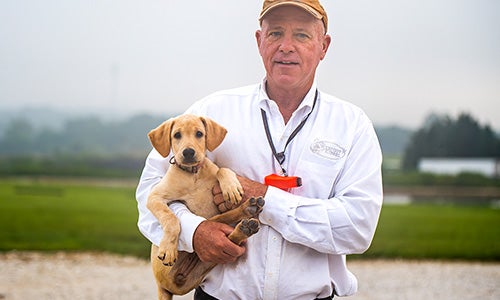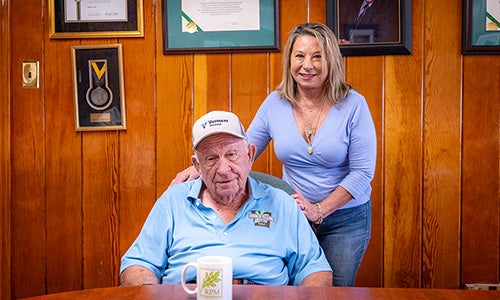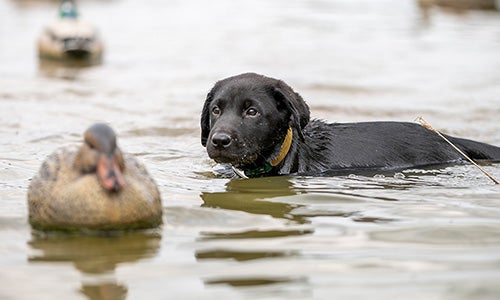Choosing a hunting dog can be a daunting task. Do you want or need a flushing breed or a pointing breed? A big bold brush buster or small pocket rocket? Male or female? A dog that runs big, or a close-in companion?
It gets even more complicated when you factor in the myriad of proven and dependable hunting dog breeds available from an array of breeders and trainers.
The good news? If you’ve done your homework, it’s hard to go wrong according to experts who cumulatively have seen, trained, trialed and tested thousands of hunting dogs.
Tom Dokken has been training dogs for more than 50 years. He’s written two books on retriever training, invented the famous Dokken Dead Fowl Trainer, created his own line of dog training products, and operates Dokken’s Oak Ridge Kennels in Minnesota, the largest gundog hunting and training kennel in the Midwest. www.dokkensoakridgekennels
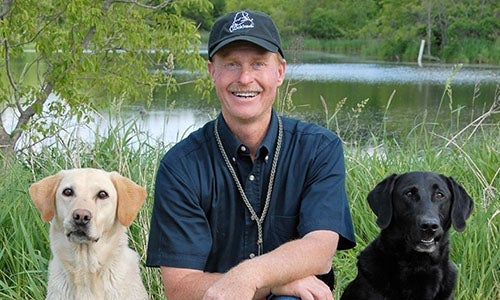
Bruce Minard and his son, Neal Minard, of Beulah, Michigan, operate Hifive Kennels, a full time breeding, training and field trial kennel since 1996. The Minards have titled dozens of bird dogs including National Champions as well as the 2019-20 Purina Coverdog of the Year Award. The Minards train all pointing breeds but specialize in English Pointers and English Setters. www.hifivekennels.com
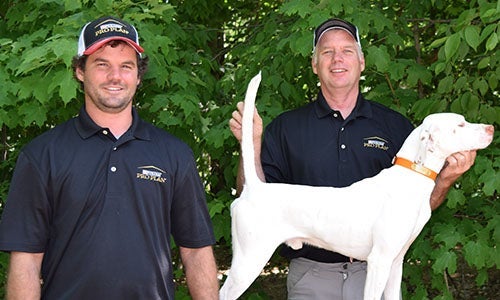
Paul McGagh is a premier professional Spaniel trainer and handler who has won nine National Championships including five Cocker National Opens, two Springer National Opens and two Canadian Nationals. He’s the only person to win those three Nationals at least twice, and the only person to win the Canadian National with a cocker. Paul, who hails from Northern England, operates Glencoe Kennels in North Dakota and California. While Paul no longer takes on client dogs for training, he continues to compete and win at trials with his own dogs.
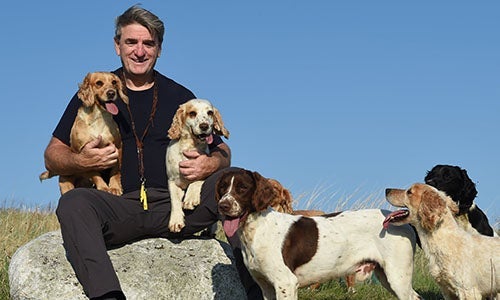
While these experts have never met and specialize in different types of hunting dogs, they share many fundamental beliefs and learnings that can contribute to finding the right hunting dog for YOU.
Bloodlines are the bottom line
Paul McGagh can trace his litters back to three bitches going back to 1991.
“I’m not saying there aren’t better lines out there, I’m just saying I know what I’m going to get,” Paul says.
And what he gets is consistently high performing Cocker Spaniels capable of winning National Championships, dogs that consistently put game in the bag, dogs that are good citizens in the house and kennel.
Tom Dokken suggests doing extensive research and buying the best bloodlines you can afford.
“A dog with a proven pedigree is likely to turn out in spite of your inexperience, lack of time, or shortcomings as a trainer,” Tom says. “We train every breed of dog. When the dog has the bloodlines, they also tend to develop a lot faster.”
Bruce Minard says a hunter can find a great dog in any breed if he or she looks hard enough.
“Just don’t buy a dog on a whim,” Bruce says. “Emotions take over and you may end up with a dog or a breed that’s not a good fit for you or your lifestyle. Do your research.”
Neal Minard adds that it’s critical to find the right breeder for the hunting you plan to do.
“Are you hunting ruffed grouse in New England or do you plan to spend most of your time hunting quail in Texas?” Neal asks. “If you can find a breeder that specializes in the type of hunting you going to do, it’s a great start.”
Finally, when selecting a bloodline and a litter, determine what health assurances or concerns may exist. Ask about OFA certification and understand the pedigree when it comes to eyes, hips, elbows or other hereditary diseases.
The Right Hunting Dog for YOUR Lifestyle
What you hunt, where you hunt, and where and how you live are important considerations when choosing your hunting dog.
“The first question you have to answer is what are you going to hunt?” Tom Dokken says. “If the answer is mostly waterfowl and some pheasant hunting, it’s hard to beat a Labrador or any of the retriever breeds. If you’re a die-hard quail hunter, now I’m shifting to the Pointers. If you plan to focus on ruffed grouse, I think of that classic English Setter.”
Tom adds that German Shorthaired Pointers are extremely popular in the Midwest – and across the country because they point, retrieve and tend to have a great personality. “What’s not to like?” Tom says.
Bruce Minard says there are probably more German Shorthaired Pointer kennels in his home state of Michigan than any other breed.
“When dogs come here for training, we don’t get into why the owner chose a certain breed,” Bruce says. “Our job is to train that dog to the best of our ability and to help that dog reach its potential. If you’re a ‘dual hunter’ – waterfowl and upland – you’ll probably go for a retriever. If you’re focused on upland hunting, you might go with a Brittany, English Setter, English Pointer, German Shorthair, German Wirehaired Pointer or other versatile dog. Any of those dogs can and will do the job.”
Tom Dokken says he doesn’t try to steer clients away from certain breeds.
“Instead, we give them information that will help with that important decision. I’d also recommend finding some mentors – people who have experience with different breeds and learning from them.”
And if you’re new to hunting or haven’t hunted with a certain breed, Neal Minard suggests finding and hiring a hunting guide.
“What better way to get your feet wet,” says Neal, who operates Grouse Ridge Guide Service when he’s not training dogs with his Dad. “First, it’s a great way to figure out if a certain type of hunting is for you. It’s also a way to see the different breeds in action – how they work and what they’re capable of. Find a guide that hunts with a breed you’re interested in. You’ll learn a lot in a hurry.”
Finding the right dog also can depend on the type of cover and terrain you’ll be hunting.
“In the Dakotas, for example, there’s a wide variety of cover,” Tom Dokken says. “You have everything from thick cattail sloughs and shelterbelts to the big grasslands and wide-open spaces. In the late season you’re often relegated to thick cover. You want a dog that will go in to the thick stuff and bust the birds. Again, retrievers and other flushing breeds like Cockers and Springer Spaniels are a great choice. But technology now makes it easier to use and find a pointing dog where you can’t see them. That GPS or a beeper collar can tell you the dog is on point 53 yards in that direction. Technology changes the game.”
Bruce Minard believes English Setters are more likely to jump into thick cover like blackberry and raspberry brambles. “A lot of English Pointers tend to like hunting the edges – they say ‘that’s a little too rough for me.’ But there’s always exceptions to that.”
Bruce says English Pointers tend to mature faster and develop faster.
“Your average winning English Setter may be 5-7 years old, where a lot of English Pointers start winning at 2.”
He adds that Hifive Kennels trains a lot of different kinds of Setters – some that work close at 25-45 yards, some that run at 300 yards.
“Buy a dog that wants to hunt with you. No matter how big a running dog he or she is, if they’re a team player you’ll never lose them.”
Considering a Cocker?
Paul McGagh says well-bred English Cocker Spaniels simply brighten your day.
“And if you don’t have a Cocker at least once in your life, you’re going to die of boredom,” Paul says.
While they come in a small package – Cockers (and Springers) can do it all in the field. They’re amazing bird finders, flush with enthusiasm and authority, are trained to sit or “hup” at the flush, and retrieve on command to hand. They also retrieve in water.
When asked to compare Cockers and Springers, Paul answers this way:
“I can bring a Cocker along maybe six months earlier than a Springer. The Springers I’ve done well with have tended to be quite sensitive and introverted. The best Cockers I’ve had have been extroverted. Because of that I can bring cockers along more quickly. I don’t like shy, sensitive Cockers and I don’t do as well with extroverted Springers. And, if you don’t mind being humiliated from time to time, Cockers might be a better choice – at least for me!”
Paul says he believes Spaniels are more adaptive to small yards and suburbia than a big-running Pointer. And while Cockers are excellent at hunting wild upland birds, Paul says they’re also a good choice for preserve hunting. “Spaniels are also terrific in the house when you start them out right.”
At the same time, Paul says Spaniels take some exercise. “They thrive on getting out every morning. But then, so do we. If you can exercise along with your hunting dogs -- it’s good for everyone.”
Tom Dokken says being able to exercise a high-energy dog frequently, if not daily, is an important consideration.
“For most hunting dogs, just taking a walk on a leash is not enough of an energy release,” Tom says. “For example, if you live in the city you’ll need to find a place where you can run those dogs to keep them in shape mentally and physically.”
Paul points out that Cockers require some maintenance – especially if you hunt in fields with cockleburs, “stick-tights” and other seeds that fasten to coats of longer-haired breeds.
“I shave my Spaniels’ coats twice a year,” Paul says.
Likewise, Bruce Minard shaves his English Setters to cut down on coat maintenance.
Labrador Retrievers, German Shorthaired Pointers and other breeds with short coats tend to run relatively unscathed through the burrs and seed patches.
Size and gender?
Our experts agree that size and gender boil down to personal preference.
“The vast majority of dogs we train tend to live in the house,” Tom Dokken says. “Male or female, they’re part of the family and socialization and puppy training should start the day you bring the dog home. Obedience is what you accept. Unwanted behavior – if you accept that – is what you get. You have basic rules, black and white. If you’re consistent, and the family is consistent, you’ll get the obedience and behavior you want.”
Tom says some people like small females, others like big males. The important part is keeping them in good body condition and at ideal weight. “In humans, you don’t see a lot of 250-pound long-distance runners,” Tom says.
Bruce Minard adds that proper nutrition for puppies and adults is paramount. “We feed and trust Purina,” he says. “Our dogs look great and perform well thanks to Pro Plan.”
A look inside the litter box
Once you’ve settled on a breed, done your research, and found a breeder and potential litter that suits you and your lifestyle – it’s time to pick a puppy.
Bruce Minard likes a bold puppy that comes right up and wants to play.
“I want a puppy that wants to be part of what you’re doing and wants to be with you constantly,” Bruce says. “That’s a dog that will hunt for you, and with you. It’s a natural bond. He doesn’t know why he wants to be with you, but he does, and that’s the one I’ll pick.”
Paul McGagh agrees and says he believes success in the field and at the field trial equates to three factors:
25 percent breeding
25 percent training
50 percent relationship
“There’s no question you need the right breeding, good training, good birds and all that. But in my opinion, the biggest part is the relationship. Make them love to be with you.”
The intangibles: Prey Drive, Bird Finding, Biddability.
Tom Dokken likens it to walking a tightrope.
“You like a dog that’s manageable, but one that also has that inherent prey drive,” Tom says. “It’s easier to get one under control than to try to give one something they don’t have to begin with.”
He likens it to the kid who tries out for the basketball team but doesn’t have the athletic ability, intensity or talent to compete. “That kid won’t be a starter. Even if he makes the team, he’ll be on the bench. When it comes to dogs, if they don’t have that prey drive, most of my clients will have trouble pulling that out.”
Tom says some clients have even insisted they don’t need a “really good dog” because they only hunt a few weekends each year.
Tom’s response?
“That’s like saying ‘I don’t go fishing that much so I don’t need a motor on my boat.’ Sure you can get by with a set of oars, but it’s not going to be a pleasurable experience! If you only hunt a few weekends each year, then you need a really good dog! You can take an average dog and hunt them a lot and they can turn out to be a pretty decent dog. If they don’t get out much, they need to be really good and well-trained when they do get out.“
First and foremost – The Foundation
No matter the breed, every great hunting dog needs a solid foundation. Even when a puppy has been well-socialized and has the right stuff – the nose, the desire, the temperament, and prey-drive - he or she still needs the basic building blocks and training regimen that make up the proper foundation and will last a lifetime. Think of building house on a shaky or shoddy foundation. It’s likely to fall down. Same goes for your hunting companion. Depending on the breed and whether it’s a flusher or pointer, teaching commands like sit, stay, come when called, heel, down, place, and kennel are part of that foundation. So is the trained retrieve. Advanced training requires a solid foundation.
“We recommend foundation training at a minimum,” Bruce Minard says. “We have a puppy foundation training program that typically starts when the pup is 6 months of age. That’s a key development time and it’s hard to get that time back. You can teach a dog to learn. With the proper foundation, even if you set it on the shelf, you can always go back.”
Tom Dokken agrees and again advocates doing research when selecting a pro trainer.
“A good pro should have a track record of setting a good foundation and be able to show you that foundation. If it’s done right, it’s always going to be there. Let’s say hunting season ends and you kind of let training slide during the off-season. If the dog has the proper foundation, it can be tuned up rather quickly. If you have no foundation whatsoever, you have nothing to work with – no matter the breed.”
Paul McGagh adds that the first six months of a puppy’s life is a special time.
“So important,” Paul says. “The habits you give them, the foundation you build carry on for a lifetime.”
He points to a litterbox full of 3-week-old English Cocker Spaniel puppies.
“We’ll keep one,” he says. “Six months from now I’ll have taught that puppy to sit, stay and retrieve with the place board. It will have that foundation and then I’ll start more serious training.”
Paul believes in taking every “event” and making it a training opportunity.
“When you feed them their Pro Plan, just don’t throw the food bowl down and walk away,” he says. “Have them sit. Wait. Make eye contact. Turn it into a training moment.”
Wild cards
Although Paul McGagh made a career by winning championships with Spaniels, a few years ago he added a talented English Pointer puppy named “Rye” to his stable of spaniels. Paul trained Rye to be steady to wing, shot and fall. He adds some pizzaz by sending in his Cockers for the flush and retrieve while Rye holds point.
“I must admit I had a real misperception about English Pointers,” Paul says. “I knew they were terrific bird finders, but I thought they were just raw-boned hunting machines without a lot of personality. I would say Rye has as much personality as any of my Spaniels and is just as good in the house. If I could only have one dog out here in the Dakotas hunting sharptail, it would be a Pointer.”
Likewise, Bruce Minard considers himself more of an English Pointer man.
“We have a Pudelpointer here right now that we’re training that’s really special,” Bruce says. “Yes, I’m an English pointer guy but I would LOVE to own that Pudelpointer.”
And Tom, after 50 years training dogs, still enjoys ‘training the trainer’ and working with owners of any breed.
“When we get to the latter stages of training, that’s when we bring the owners in. We set a standard and show the owners – here’s what your dog is capable of and here’s what you need to do to keep it that way.” Dogs are smart. It will take a dog about 15 minutes to figure out what they can get away with. The owner – and his or her family – need to take over the training and enforce the rules. The dogs will respect that. And you will have a dog that hunts for you!”








